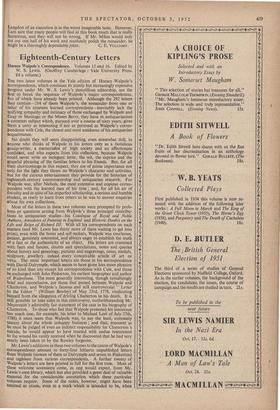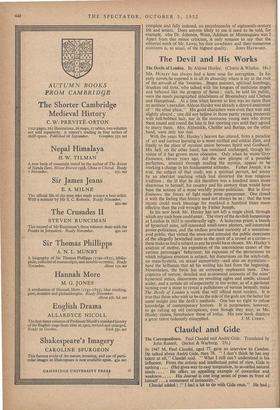Eighteenth-Century Letters
THE two latest volumes in the Yale edition of Horace Walpole's correspondence, which continues its stately but increasingly expensive Progress under Mr. W. S. Lewis's punctilious editorship, are the first to 'break the sequence of Walpole's major correspondences, five of which have already been printed. Although the 292 letters they contain-214 of them Walpole's, the remainder from one or other of his nineteen learned correspondents—inevitably lack the Unifying sympathy and intimacy of those exchanged by Walpole and Gray or Montagu or the Misses Berry, they have in antiquarianism a common subject which, pursued over a course of sixty years, gives them a unity as interesting if not as personal as Walpole's corres- pondence with Cole, the closest and most assiduous of his antiquarian acquaintance.
No doubt they will seem disappointing, even somewhat dull, to anyone who thinks of Walpole in his letters only as a fastidious gossip-writer, a memorialist of high society and an affectionate confidant, and who expects from this collection, because Walpole could never write an inelegant letter, the wit, the caprice and the graceful phrasing of the familiar letters to his friends. But, for all their shortcomings in this respect, they are of prime importance not only for the light they throw on Walpole's character and activities, but for the curious entertainment they provide for the historian of eighteenth-century connoisseurship and antiquarian research. For Walpole was, after Nichols, the most extensive and copious corres- pondent with the learned men of his time ; and, for all his air of frivolity and in spite of his imperfect scholarship, a serious and humble student, as ready to learn from others as he was to answer enquiries about his own collections.
Most of the letters in these two volumes were prompted by prob- lems or questions arising from Walpole's three principal contribu- tions to antiquarian studies—his Catalogue of Royal and Noble Authors, Anecdotes of Painting in England and Historic Doubts on the Life and Reign of Richard ILL With all his correspondents on such matters (and Mr. Lewis has thirty more of them waiting to get into print), even with the bores and self-seekers, Walpole was courteous, patient, genuinely interested, and always eager to establish the truth of a fact or the authenticity of an object. His letters are crammed with facts and fancies, doubts and speculations, notes and queries about history and genealogy, pictures and engravings, coins, medals, sculpture, jewellery, indeed every conceivable article of art or virtu. The most important letters are those in his correspondence with David Dalrymple, which seems to have given him more pleasure of its kind than any except his correspondence with Cole, and those he exchanged with John Pinkerton, his earliest biographer and author of Walpoliana. The most generally interesting, though tantalisingly brief and inconclusive, are those that passed between Walpole and Chatterton, and Walpole's famous and still controversial " Letter to the Editor " (William Bewley) of May 23rd, 1778, vindicating himself from the allegation of driving Chatterton to his death. It is still possible to take sides in this controversy, nothwithstanding Mr. Meyerstein's admirably fair statement of the case in his biography of Chatterton. To those who feel that Walpole protested his innocence too much (see, for example, his letter to Michael Lort of July 27th, 1788) it must seem that Walpole was, to say the least, extremely uneasy about the whole unhappy business ; and that, innocent as he must be judged of even an indirect responsibility for Chatterton's suicide, he would appear to have reacted with undue resentment to the wound his vanity received when he discovered that he had very nearly been taken in by the Rowley forgeries.
Mr. Lewis's additions in these two volumes to the canon of Walpole's correspondence amount to forty-four hitherto unpublished letters from Walpole (sixteen of them to Dalrymple and seven to Pinkerton) and eighteen from various correspondents. A further twenty of Walpole's letters are here printed in full for the first time. Most of these welcome accessions come, as one would expect, from Mr. Lewis's own library, which has also provided a great deal of valuable material for the considerable annotation which these particular volumes require. Some of the notes, however, might have been omitted as otiose, even in a work. which is intended to be, when complete and fully indexed, an encyclopaedia of eighteenth-century life and letters. Does anyone likely to use it need to be told, for example, who Dr. Johnson, Wren, Addison or Montesquieu was 7 Apart from this minor criticism, it only remains to say that the editorial work of Mr. Lewis, his four co-editors and their numerous assistants is, as usual, of the highest quality. JOHN HAYWARD.



















































 Previous page
Previous page